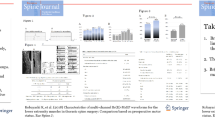Abstract
Jasiukaitis and Lyon (J Clin Monit Comput, https://doi.org/10.1007/s10877-018-0181-9, 2018) described an motor evoked potential (MEP)amplitude trending system to detect MEP amplitude loss against a background of MEP variability. They found that the end of case value of a running R2 triggered by a set MEP amplitude loss criterion appeared to discriminate new injury from non-injury in a small sample of three patients. The present study examines the predictive capability of the running R2 in a larger sample of patients (21 injured and 19 non-injured). It also varies the amplitude loss criterion (50%, 65% and 80%) for triggering the running R2 and the numbers of points used in the moving linear regression (8, 12 and 16). 40 patients who had undergone correction for lumbar deformity were retrospectively examined. 21 of these woke up with a newly acquired radicular injury, 19 did not but were characterized by hypovolemic hemorrhage. All 40 patients had sufficient MEP amplitude loss sometime during their procedure to cause the monitoring specialist to report this to the surgeon and anesthesia. End-of-case running R2s were significantly larger in the injury group. Using an 80% amplitude loss criterion to trigger the running R2 proved to be too stringent, causing reduced sensitivity. The running R2 appeared to have equivalent sensitivity to that of conventional MEP amplitude loss ratios, but superior specificity within this monitoring challenged sample. The different number of points for the moving regressions did not have any significant effect. End-of-case R2 values greater than 60% appeared to be highly predictive of new post-operative deficit, while values less than 40% appeared to insure no new deficit. The proposed trending system can discriminate injury from non-injury outcomes when compressive radicular injury during correction for lumbar deformity is involved. This discrimination appears to be successful even when MEP amplitude loss for non-iatrogenic reasons (i.e., hemorrhage) is also occurring.



Similar content being viewed by others
References
Buchowski JM, Bridwell KH, Lenke LG, Kuhns CA, Lehman RA Jr, Kim YJ, Stewart D, Baldus C. Neurologic complications of lumbar pedicle subtraction osteotomy: a 10-year assessment. Spine 2007;32(20):2245–52.
Ghobrial GM, Williams KA Jr, Arnold P, Fehlings M, Harrop JS. Iatrogenic neurologic deficit after lumbar spine surgery: a review. Clin Neurol Neurosurg. 2015;139:76–80.
Hays WL. Statistics. New York: Holt, Rinehart & Winston; 1988.
Jasiukaitis P, Lyon R. A motor evoked potential trending system may discriminate outcome: retrospective application with three cases. J Clin Monit Comput. 2018. https://doi.org/10.1007/s10877-018-0181-9.
Kim DH, Zaremski J, Kwon B, Jenis L, Woodard E, Bode R, Banco RJ. Risk factors for false positive transcranial motor evoked potential monitoring alerts during surgical treatment of cervical myelopathy. Spine. 2007;32(26):3041–6.
Kleinbaum DG, Kupper LL, Muller KE. Applied regression analysis and other multivariable methods. 2nd ed. Boston: PWS-Kent Publishing Co.; 1988.
Langeloo DD, Journée HL, de Kleuver M, Grotenhuis JA. Criteria for transcranial electrical motor evoked potential monitoring during spinal deformity surgery a review and discussion of the literature. Neurophysiol Clin. 2007;37(6):431–9.
Lieberman JA, Lyon R, Feiner J, Hu SS, Berven SH. The efficacy of motor evoked potentials in fixed sagittal imbalance deformity correction surgery. Spine J. 2008;33(13):E414–24.
Lieberman JA, Lyon R, Jasiukaitis P, Berven SH, Burch S, Feiner J. (2018), The reliability of motor evoked potentials to predict dorsiflexion injuries during lumbosacral deformity surgery: importance of multiple myotomal monitoring. Spine J.
Lyon R, Feiner J, Lieberman JA. Progressive suppression of motor evoked potentials during general anesthesia: the phenomenon of “anesthetic fade”. J Neurosurg Anesthesiol. 2005;17(1):13–9.
Macdonald DB, Stigsby B, Al Homoud I, Abalkhail T, Mokeem A. Utility of motor evoked potentials for intraoperative nerve root monitoring. J Clin. Neurophysiol. 2012;29(2):118–25.
Overall JE, Klett CJ. Applied multivariate analysis. New York: McGraw-Hill; 1972.
Pinder JP. Introduction to business analytics using simulation. London: Academic Press; 2017.
Pateder DB, Kostuik JP. Lumbar nerve root palsy after adult spinal deformity surgery. Spine. 2005;30(14):1632–6
Remington RD, Schork MA. Statistics with applications to the biological & health sciences. 2nd ed. Englewood Cliffs: Prentice Hall; 1985.
Schwartz DM, Auerbach JD, Dormans JP, Flynn J, Drummond DS, Bowe JA, Laufer S, Shah SA, Bowen JR, Pizzutillo PD, Jones KJ, Drummond DS. Neurophysiological detection of impending spinal cord injury during scoliosis surgery. J Bone Joint Surg Am. 2007;89(11):2440–9.
Sutter MA, Eggspuehler A, Grob D, Porchet F, Jeszensky D, Dvorak J. Multimodal intraoperative monitoring (MIOM) during 409 lumbrosacral surgicla procedures in 409 patients. Eur Spine J. 2007;16(Suppl 2):221–8.
Tamkus A, Rice KS, Hoffman G. Transcranial motor evoked potential alarm criteria to predict foot drop injury during lumbosacral surgery. Spine. 2018;43(4):E227–33.
Traba A, Romero JP, Arranz B, Vilela C. A new criterion for detection of radiculopathy based on motor evoked potentials and intraoperative nerve root monitoring. Clin Neurophysiol. 2018;129:2075–82.
Zhuang Q, Wang S, Zhang J, Zhao H, Wang Y, Tian Y, Zhao Y, Li S, Weng X, Qiu G. How to make the best use of intraoperative motor evoked potential monitoring? Experience in 1162 consecutive spinal deformity surgical procedures. Spine. 2007;39(24):E1425–32.
Author information
Authors and Affiliations
Corresponding author
Ethics declarations
Conflict of interest
The authors have no conflict of interest with regards to this study.
Ethical approval
The data reported are retrospective data. Patient treatment was not altered or affected in any way by gathering this data. No patient or medical provider identities are revealed in the submitted article.
Additional information
Publisher's Note
Springer Nature remains neutral with regard to jurisdictional claims in published maps and institutional affiliations.
Paul Jasiukaitis: CNIM (retired).
Rights and permissions
About this article
Cite this article
Jasiukaitis, P., Lyon, R. Trending algorithm discriminates hemodynamic from injury related TcMEP amplitude loss. J Clin Monit Comput 34, 131–137 (2020). https://doi.org/10.1007/s10877-019-00272-5
Received:
Accepted:
Published:
Issue Date:
DOI: https://doi.org/10.1007/s10877-019-00272-5




